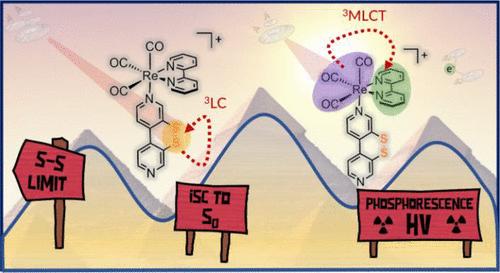当前位置:
X-MOL 学术
›
J. Am. Chem. Soc.
›
论文详情
Our official English website, www.x-mol.net, welcomes your feedback! (Note: you will need to create a separate account there.)
Bifurcation of Excited-State Population Leads to Anti-Kasha Luminescence in a Disulfide-Decorated Organometallic Rhenium Photosensitizer
Journal of the American Chemical Society ( IF 15.0 ) Pub Date : 2024-04-10 , DOI: 10.1021/jacs.4c00548 Julia Franz 1 , Manuel Oelschlegel 2 , J. Patrick Zobel 1 , Shao-An Hua 2 , Jan-Hendrik Borter 3 , Lucius Schmid 4 , Giacomo Morselli 4 , Oliver S. Wenger 4 , Dirk Schwarzer 3 , Franc Meyer 2, 5 , Leticia González 1, 6
Journal of the American Chemical Society ( IF 15.0 ) Pub Date : 2024-04-10 , DOI: 10.1021/jacs.4c00548 Julia Franz 1 , Manuel Oelschlegel 2 , J. Patrick Zobel 1 , Shao-An Hua 2 , Jan-Hendrik Borter 3 , Lucius Schmid 4 , Giacomo Morselli 4 , Oliver S. Wenger 4 , Dirk Schwarzer 3 , Franc Meyer 2, 5 , Leticia González 1, 6
Affiliation

|
We report a rhenium diimine photosensitizer equipped with a peripheral disulfide unit on one of the bipyridine ligands, [Re(CO)3(bpy)(S–Sbpy4,4)]+ (1+, bpy = 2,2′-bipyridine, S–Sbpy4,4 = [1,2]dithiino[3,4-c:6,5-c′]dipyridine), showing anti-Kasha luminescence. Steady-state and ultrafast time-resolved spectroscopies complemented by nonadiabatic dynamics simulations are used to disclose its excited-state dynamics. The calculations show that after intersystem crossing the complex evolves to two different triplet minima: a (S–Sbpy4,4)-ligand-centered excited state (3LC) lying at lower energy and a metal-to-(bpy)-ligand charge transfer (3MLCT) state at higher energy, with relative yields of 90% and 10%, respectively. The 3LC state involves local excitation of the disulfide group into the antibonding σ* orbital, leading to significant elongation of the S–S bond. Intriguingly, it is the higher-lying 3MLCT state, which is assigned to display luminescence with a lifetime of 270 ns: a signature of anti-Kasha behavior. This assignment is consistent with an energy barrier ≥ 0.6 eV or negligible electronic coupling, preventing reaction toward the 3LC state after the population is trapped in the 3MLCT state. This study represents a striking example on how elusive excited-state dynamics of transition-metal photosensitizers can be deciphered by synergistic experiments and state-of-the-art calculations. Disulfide functionalization lays the foundation of a new design strategy toward harnessing excess energy in a system for possible bimolecular electron or energy transfer reactivity.
中文翻译:

激发态布居的分叉导致二硫化物修饰的有机金属铼光敏剂中的反 Kasha 发光
我们报道了一种在联吡啶配体之一上配备有外围二硫化物单元的铼二亚胺光敏剂,[Re(CO) 3 (bpy)( S–S bpy 4,4 )] + ( 1 + , bpy = 2,2′-联吡啶,S–S bpy 4,4 = [1,2]dithiino[3,4- c :6,5- c ']联吡啶),显示抗 Kasha 发光。稳态和超快时间分辨光谱辅以非绝热动力学模拟,用于揭示其激发态动力学。计算表明,系间穿越后,配合物演化为两个不同的三重态最小值:处于较低能量的(S–S bpy 4,4)-配体中心激发态(3 LC)和金属-(bpy)-配体电荷转移 ( 3 MLCT) 状态在较高能量下,相对产率分别为 90% 和 10%。3 LC态涉及二硫基团局部激发进入反键σ*轨道,导致S-S键显着伸长。有趣的是,它是位置较高的3 MLCT 态,它被分配显示寿命为 270 ns 的发光:反 Kasha 行为的标志。此分配与能量势垒 ≥ 0.6 eV 或可忽略不计的电子耦合一致,防止群体被困在3 MLCT 状态后发生向3 LC 状态的反应。这项研究提供了一个引人注目的例子,说明如何通过协同实验和最先进的计算来破译过渡金属光敏剂难以捉摸的激发态动力学。二硫键功能化为新的设计策略奠定了基础,该策略旨在利用系统中的多余能量来实现可能的双分子电子或能量转移反应。
更新日期:2024-04-10
中文翻译:

激发态布居的分叉导致二硫化物修饰的有机金属铼光敏剂中的反 Kasha 发光
我们报道了一种在联吡啶配体之一上配备有外围二硫化物单元的铼二亚胺光敏剂,[Re(CO) 3 (bpy)( S–S bpy 4,4 )] + ( 1 + , bpy = 2,2′-联吡啶,S–S bpy 4,4 = [1,2]dithiino[3,4- c :6,5- c ']联吡啶),显示抗 Kasha 发光。稳态和超快时间分辨光谱辅以非绝热动力学模拟,用于揭示其激发态动力学。计算表明,系间穿越后,配合物演化为两个不同的三重态最小值:处于较低能量的(S–S bpy 4,4)-配体中心激发态(3 LC)和金属-(bpy)-配体电荷转移 ( 3 MLCT) 状态在较高能量下,相对产率分别为 90% 和 10%。3 LC态涉及二硫基团局部激发进入反键σ*轨道,导致S-S键显着伸长。有趣的是,它是位置较高的3 MLCT 态,它被分配显示寿命为 270 ns 的发光:反 Kasha 行为的标志。此分配与能量势垒 ≥ 0.6 eV 或可忽略不计的电子耦合一致,防止群体被困在3 MLCT 状态后发生向3 LC 状态的反应。这项研究提供了一个引人注目的例子,说明如何通过协同实验和最先进的计算来破译过渡金属光敏剂难以捉摸的激发态动力学。二硫键功能化为新的设计策略奠定了基础,该策略旨在利用系统中的多余能量来实现可能的双分子电子或能量转移反应。



























 京公网安备 11010802027423号
京公网安备 11010802027423号